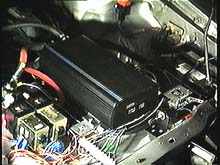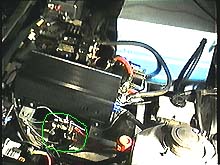Hello, Curtis!
My, it HAS been a long time! I've been here in Zapi purgatory waiting for word on my controller and Zivan charger without much response. The loaner controller came much later than I anticipated (just got it a few weeks ago) and it took me a few days to install it. And then there was the issue of how the heck do I CHARGE 12 batteries!
Status of my broken gear:
Gary Flo and Greg McCrea (I sent my Zivan Charger to Greg: I believe he is or is going to be the
US tech rep for Zapi, but no official word) both spent part of September in Europe. Part of
the trip, as I understand it, is to try setting up better lines of communications and parts
with Zapi & the US. This would be great. Gary assured me that Zapi was intending to fix my H3
problem, but details beyond that are not avialable. A working H3 would be just as acceptable as
a refund, and I requested at least a spare logic board so it doesn't become another 2-3 month wait
should a failure occur. It sounds like they are working towards a longer term solution, still, it is frustrating not to hear any status.
Okay, that's the controller news. I haven't gotten in touch with Greg McCrea yet, and
don't know what's up with my Zivan charger. Since it has been out of action even longer than the H3,
I've decided to buy another charger. I'd prefer to get my money back for the Zivan or sell it
back at a slight loss, but in the worst case I've learned an expensive lesson and will own two
chargers. To the Zivan's credit there are a number of people who use these without any problems
and it worked well for me. But three months for repair/replacement is too much.
The new charger is on order and it is a Bycan charger purchased through EVA. Bycan is a US (California?)
based company and this is a "monster" charger. Designed by experienced battery engineers it can
be charged from either 110vac or 240vac, supports various battery pack voltages, and has temperature
probes and other extras. The downsize is that it weighs 40lbs and might not be suitable for life
as an onboard charger. We'll see.
Curtis 1231C
The controller Gary sent for a loaner is the latest from Curtis, a company that has been in the
controller business for quite some time. The 1231C I am using is a 144vdc unit with a current
rating of 500 amps, this compared with the 800 amps of the Zapi.
Comparing the two controllers you'll immediately notice that the Curtis is a nicely packaged,
cleanly constructed module with only a handfull of connections. Wiring it up is very simple and
it just works. The documentation is very nice and clear, with extra pullout wiring guide cards, color
coded to help ensure a proper install. It took me a little longer to install the Curtis primarily
because I was trying to shoehorn it in where the Zapi had resided, using the same heavy
cables since I didn't have any extra cables or connectors. Something of a jigsaw puzzle
which required moving some contactors around, but in the end everything got hooked up
and works.
 |
 |
Now for the comparison
The Curtis has minimal adjustments (you may be able to see the
three small holes in the side of the unit): acceleration rate, current limit,
and plug braking (which doesn't really apply to EVs, more for fork lifts). The manual gives
safety warnings to follow when making adjustments, but doesn't actually tell you how to
make the adjustments or check them, but they do tell you how to unscrew and re-screw in the
protective hex nuts which cover the adjustment holes, which seems odd. I haven't
touched these, all settings are factory preset.
The 1231C has one immediate drawback: noise.
The one thing I do a lot of with the EV is give people a ride, often their very first
experience with an EV. With the Zapi H3 this was fun because it is completely silent
and people were amazed to be accelerating down the road without any sound but the tires
rolling. Not so with the Curtis, stepping on the accelerator produces a LOUD and
attention getting 1.5khz tone, kind of like the test tone during radio station's emergency
broadcast tests. I wince everytime I hear it, even though it goes away a few seconds later as you
pick up speed. The Curtis manual calls this "the frequency shifting feature" and states that it
"improves the current limit control and also helps protect the controller when the motor is in
near-stall conditions".
The other difference for me came when backing up. With the Zapi I used it's electronic reverse feature
and was able to adjust the acceleration rate when backing up, even the limits of backup current.
On the Curtis there is no such thing and what you get when you go forward is exactly what you get
when you back up and the suddeness of the acceleration has caught me off guard a couple of times.
To it's defense the Curtis is very simple to install and understand. Plus it works! I haven't
had any problems in the week that I've been using it. And I understand from others that service
and support with the Curtis is good.
Charging 12 batteries
So I get the brand new Curtis installed, go for a cruise, suck down some amps, head back home.
Now I have a pack of batteries that are mighty thirsty. Well, time to setup the 12volt charger
and charge one battery at a time. This is a PAIN, let me tell you. Each battery takes from 4-8 hours
to charge (depending on how drained they are) and then you manually switch to charging the next
battery. Ok, so 2-3 days to charge, not exactly a workable solution, but all I had for a while.
The difference between a single battery charger and one which will charge the full pack is significant,
on the order of 12 times more voltage. I know there's a way to "hack" a battery charger, but it
isn't very elegant and has extremely limited control. But after a few tries at charging all of the
batteries one by one I call up some parts suppliers and get to work. Some folks call this the
"bad boy" charger. It takes advantage of the attribute of AC power in that even though the useable
or effective voltage is 120vac, the peaks are much higher, in fact high enough to charge a 144vdc
string of batteries. What I ended up making was a manually controlled charger using a variac, bridge
rectifier, blocking diode (to keep the pack voltage away from the bridge & variac), and of course
a fuse. It requires steady supervision on my part and manual adjustment to maintain current flow,
but in the end it will charge ALL of the batteries in one evening. It's a good, emergency charger
but nothing I'd want to depend on.
Oh, one other thing. While installing the Curtis I also finished the install of my heater circuit.
You'll notice a green circle in the second picture above, this is the relay that turns on the heater.
I have a switch in the compartment which turns on/off this relay using the 12vdc system. The relay
contacts connect the heater core (ceramic heater) to the battery pack. I've used it on a few
chilly mornings and it works, you get immediate heat and since it is integrated into the car's
existing heater core area the heat is available for defrosting windows or thawing toes. Current
draw is around 12 amps, this compared with the 60-70 amps the EV pulls while driving down a flat
section of road at 35 mph. Climbing a hill can pull 200-400 amps, so a dozen amps for heating seems
almost insignificant, but it adds up like anything else. I'll let you know how it goes when the
temperatures really get cold.